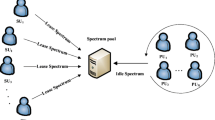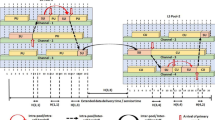Abstract
We propose a non-cooperative game theory based algorithm for spectrum management problem in cognitive radio networks taking into account the spectrum handoff effects. The objective is to minimize the spectrum access time of Secondary Users (SUs) which are competing for spectrum opportunities in heterogeneous environment. In this paper, the preemptive resume priority (PRP) M/G/1 queuing model is used to characterize the multiple handoff and data delivery time of SUs. Also an explicit solution for channels selection probabilities of each SU is extracted for PRP M/M/1 model specifically. The effect of handoffs is considered as the interrupted packets which return to the SUs’ low priority queue when the high priority Primary User’s packets are arrived to take service. The queuing delay of SUs’ and the effect of these returned packets are considered in order to balance the load of SUs on channels so that the minimum spectrum access time is sensed by each SU. The non-cooperative spectrum load balancing with handoff management game is proposed to find a distributed solution for each SU. It is shown that this game has a unique Nash equilibrium point which can be achieved by SUs as decision makers. At this equilibrium, each SU incurs the minimum delay on all channels while the free spectrum holes of channels are utilized efficiently. Simulation results are provided to evaluate the performance of the proposed scheme in terms of spectrum access delay, fairness, and channels spectrum holes utilization.












Similar content being viewed by others
References
Haykin, S. (2005). Cognitive radio: Brain-empowered wireless communications. IEEE Journal on Selected Areas in Communications, 23(2), 201–220.
Mitola, J., et al. (1999). Cognitive radio: Making software radios more personal. IEEE Personal Communications, 6(4), 13–18.
Zhao, Q., & Sadler, B. M. (2007). A survey of dynamic spectrum access. IEEE Signal Processing Magazine, 24(3), 79–89.
Akyildiz, I. F., Lee, W.-Y., Vuran, M. C., & Mohanty, S. (2006). NeXt generation/dynamic spectrum access/cognitive radio wireless networks: A survey. Computer Networks, 50(13), 2127–2159.
Wang, L. C., Wang, C. W., & Adachi, F. (2011). Load balancing spectrum decision for cognitive radio networks. IEEE Journal on Selected Areas in Communications, 29(4), 757–769.
Lo, S.-C., & Tseng, C.-W.T. (2007). A novel multi-channel MAC protocol for wireless ad hoc networks. In IEEE Vehicular Technology Conference (VTC 2007), Dublin, Ireland (pp. 46–50).
Kim, T.-S., Lim, H., & Hou, J. C. (2008). Understand and improving the spatial reuse in multihop wireless networks. IEEE Transaction on Mobile Computing, 7(10), 1200–1212.
Zhao, Q., Geirhofer, S., Tong, L., & Sadler, B. M. (2008). Opportunistic spectrum access via periodic channel sensing. IEEE Transaction on Signal Processing, 56(2), 785–796.
Berlemann, L., Mangold, S., Hiertz, G. R., & Walke, B. (2006). Spectrum load smoothing: Distributed quality-of-service support for cognitive radios in open spectrum. European Transactions on Telecommunications, 17(3), 395–406.
Chen, Q., Chen, J., & Tang, L. (2009). Dynamic spectrum load balancing for cognitive radio. In International symposium on computer network and multimedia technology (CNMT 2009). Wuhan, China (pp. 1–4).
Fischer, S., Petrova, M., Mahonen, P., & Vocking, B. (2007). Distributed load balancing algorithm for adaptive channel allocation for cognitive radios. In Proceedings of the 2nd conference cognitive radio oriented wireless networks and communications (CrownCom 2007). Orlando, FL (pp. 508–513).
Fischer, S., Mahonen, P., & Schongens, M. (2008). Load balancing for dynamic spectrum assignment with local information for secondary users. In 3rd IEEE symposium on new Frontiers in dynamic spectrum access networks (DySPAN 2008), Chicago, IL (pp. 1–9).
Shiang, H. P., & van der Schaar, M. (2008). Queuing based dynamic channel selection for heterogeneous multimedia application over cognitive radio networks. IEEE Transaction on Multimedia, 10(5), 896–909.
Chronopoulos, A. T., Musku, M. R., Penmatsa, S., & Popescu, D. C. (2008). Spectrum load balancing for medium access in cognitive radio systems. IEEE Communication Letters, 12(5), 353–355.
Wang, L.-C., & Wang, C.-W. (2008). Spectrum handoff for cognitive radio networks: Reactive-sensing or proactive-sensing? In IEEE international conferance on performance: Computing and communications, Austin, Texas (pp. 343–348)
Wang, C.-W., & Wang, L.-C. (2010). Modeling and analysis for reactive-decision spectrum handoff in cognitive radio networks. In Global Telecommunications Conference (GLOBECOM 2010), Miami, FL (pp. 1–6).
Baroudi, U., & Alfadhly, A. (2011). Effect of mobility and primary appearance probability on spectrum handoff. In IEEE 73rd Vehicular Technology Conference (VTC 2011), Yokohama, Japan (pp. 1–6).
Wang, C.-W., & Wang, L.-C. (2009). Modeling and analysis for proactive-decision pectrum handoff in cognitive radio networks. In IEEE international conference on communications, (ICC 2009) (pp. 1–6).
Song, Y., & Xie, J. (2010) Common hopping based proactive spectrum handoff in cognitive radio ad hoc networks. In IEEE Global Telecommunications Conference (GLOBECOM 2010), Miami, FL (pp. 1–5).
Yang, L., Cao, L., & Zheng, H. (2008). Proactive channel access in dynamic spectrum networks. Physical Communication, 1(2), 103–111.
Liu, H.-J., Wang, Z.-X., Li, S.-F., & Yi, M. (2008). Study on the performance of spectrum mobility in cognitive wireless network. In IEEE Singapore international conference on communication systems (ICCS 2008), Guangzhou, China (pp. 1010–1014).
Wang, L.-C., Wang, C.-W., & Feng, K.-T. (2011). A queueing-theoretical framework for QoS-enhanced spectrum management in cognitive radio networks. IEEE Wireless Communications, 18(6), 18–26.
Wang, L. C., Wang, C. W., & Chang, C. J. (2012). Modeling and analysis for spectrum handoffs in cognitive radio networks. IEEE Transactions on Mobile Computing, 11(9), 1499–1513.
Fahimi, M., & Ghasemi, A. (2014). Modeling and analysis the PRP M/G/1 queuing system for cognitive radio networks with handoff effects and stability conditions. In Proceedings of the Iranian Conference on Electrical Engineering (ICEE 2014), Iran, Tehran.
Kleinrock, L. (1975). Queuing systems (1st ed.). New York: Wiley-Interscience.
Bertsekas, D., & Gallager, R. (1987). Data networks (1st ed.). Upper Saddle River, NJ: Prentice Hall Inc.
Kim, C., & Kameda, H. (1992). An algorithm for optimal static load balancing in distributed computer systems. IEEE Transactions on Computers, 41(3), 381–384.
Osborn, M. J., & Rubinstein, A. (1998). A course in game theory (1st ed.). Cambridge, MA: MIT Press.
Fudenberg, D., & Levine, D. K. (1998). Game theory (1st ed.). Cambridge, MA: MIT Press.
Scutari, G., Palomar, D. P., Facchinei, F., & Pang, J.-S. (2010). Convex optimization, game theory and variational inequality theory. IEEE Signal Processing Magazine, 27(3), 35–49.
Boyd, S., & Vandenberghe, L. (2004). Convex optimization. Cambridge, MA: Cambridge University Press.
Grosu, D., & Chronopoulos, A. (2005). Noncooperative load balancing in distributed systems. Journal of Parallel and Distributed Computing, 65(9), 1022–1034.
Ross, S. M. (1996). Stochastic processes (2nd ed.). New York: Wiley.
Jain, R. (1991). The art of computer systems performance analysis: Techniques for experimental design, measurement, simulation, and modeling. New York: Wiley.
Author information
Authors and Affiliations
Corresponding author
Appendices
Appendix 1: Proof of proposition 1
If the strategy set of players is compact then a nonempty set of Nash equilibrium solution will exist [30]. In addition, the sufficient condition for the uniqueness of Nash equilibrium is that the cost function of each player is a strongly convex function in the strategy space. The domain of the problem which is given by (16) and (17) is a convex set. Using (28) and (29) we find that the derivation of the cost function in (10), exists and taking into account (18) its hessian is positive definite. Therefore, the cost function is strongly convex. In (29) and (30), we have:
Appendix 2: Proof of proposition 2
In order to compute an explicit solution for (25), we use the logarithmic barrier method by applying KKT conditions [30, 31]. In optimization problem (25), there is one equality condition and three inequality conditions. Since \(\sum _{i =1}^{M}s_{ji}=1\) we can ignore the condition \(s_{ji} \le 1\). Let \(\alpha _j,\,\beta _{ji}\), and \(\eta _{ji}\) denote the Lagrange multipliers for constraints \(\sum _{i =1}^{M}s_{ji}=1,\,s_{ji} \ge 0\), and the last constraint in (25). The Lagrangian of (25) is given by:
In (37), \(\beta _{ji}(-s_{ji}) =0\) and \(\eta _{ji} \left( s_{ji}\lambda _{j}^{( SU )}(1+P_{ji}^{h})+\sum _{k=1,k\ne j}^{N}(s_{ki}\lambda _{k}^{( SU )}(1+P_{ki}^{h}) )+\lambda _{i}^{( PU )}-\mu _i\right) = 0, i=1,\ldots ,M.\)In order to find the optimum solution of this Lagrangian, we use Logarithmic barrier method which approximates the cost function without inequality conditions. In Logarithmic barrier method the cost function \(c_j^{m}({\mathbf{s}}_j,{\mathbf{s}}_{-j})\) can be written as:
and the Lagrangian is:
If r is large enough, \(\beta _{ji}(-s_{ji}) = \frac{1}{r}\) and \(\eta _{ji} \left( s_{ji}\lambda _{j}^{( SU )}(1+P_{ji}^{h})\,+\sum _{k=1,k\ne j}^{N}(s_{ki}\lambda _{k}^{( SU )}(1+P_{ki}^{h}) )+\lambda _{i}^{( PU )}-\mu _i\right) =\frac{1}{r}.\) The derivation and hessian of this Lagrangian can be computed by (33) and (34):
By applying Newton step in logarithmic barrier method, we can compute the explicit solution for \(\alpha _j\) and \(s_{ji}\). The Newton step in logarithmic barrier method is given by [31]:
By considering the condition (17), \(\sum _{i =1}^{M}\varDelta {s_{ji}} =0\) and by this condition the value of \(\alpha _j\) in each step can be computed by:
By computing the derivation, hessian and Lagrange multiplier we can reach to optimum solution of (25) iteratively by:
In optimum solution, which is denoted by \(s_{ji}^{*}\), we have \(-\alpha _j = G_{ji}\). We can compute the explicit solution for \(s_{ji}^{*}\) in M/M/1 queuing model. For M/M/1, the value of \(G_{ji}\) is:
By solving the \(-\alpha _j = G_{ji}\), we have:
where \(Q = \left( -\alpha _j -\frac{1}{\mu _i}- \frac{\lambda _i^{( PU )}}{\mu _i} \left(\frac{1}{\mu _i-\lambda _i^{( PU )}}\right)\right) \left(\mu _i-\lambda _i^{( PU )}\right)\).
Therefore if there exists a feasible solution for the system the best strategy of \(SU _j\) for selecting channel \(F_i\) at the Nash equilibrium, \(s_{ji}^*\), is given by:
Rights and permissions
About this article
Cite this article
Fahimi, M., Ghasemi, A. Joint spectrum load balancing and handoff management in cognitive radio networks: a non-cooperative game approach. Wireless Netw 22, 1161–1180 (2016). https://doi.org/10.1007/s11276-015-1023-z
Published:
Issue Date:
DOI: https://doi.org/10.1007/s11276-015-1023-z




